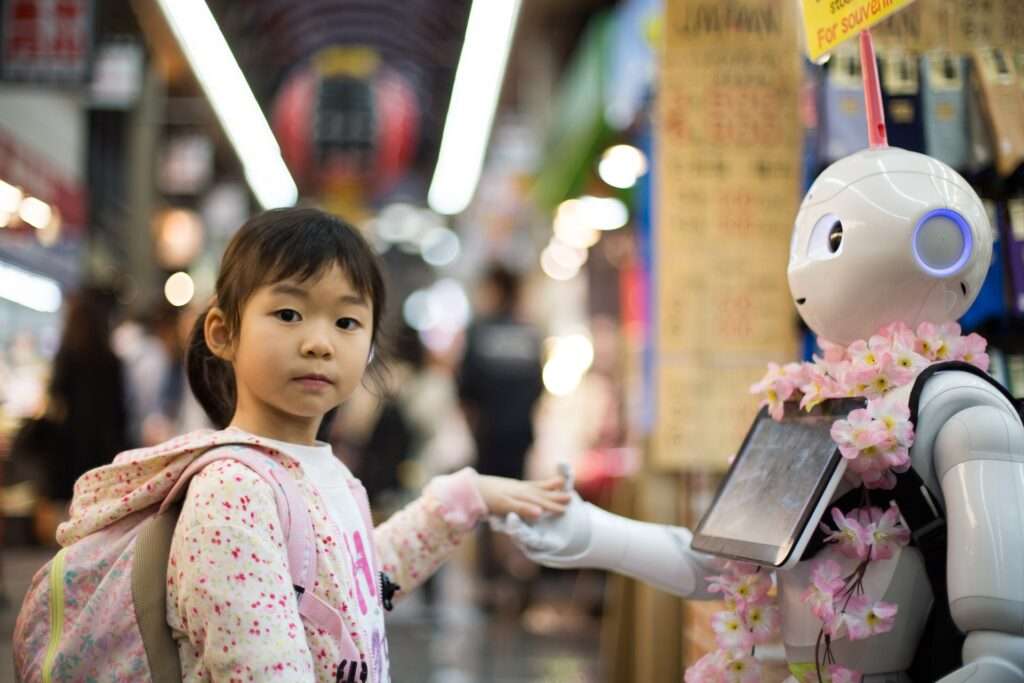By Helen Steiger
Artificial Intelligence is coming…well actually, it’s already here and changing a lot of our working practices (whoever knew ChatGPT could have so many useful and useless applications eh?!)
But for us Curious Earthers the question is, what are the environmental and social implications of these new technological developments? How could AI contribute to a sustainable future, and even accelerate action in a meaningful and impactful way? And conversely – what are the environmental and social downsides to watch-out for as developments continue?
This week, we’re diving deeper into the opportunities and risks that AI poses to people and our planet, examining how it might help, or hinder, our fight for a sustainable future…
Ok, what do we mean by AI in this instance?
Good question, because actually, this term has many different definitions depending on the topic, the audience, and the author.
In its simplest form – artificial intelligence is a machine’s ability to perform the cognitive functions we usually associate with human minds.
Within this, there are two commonly mentioned types of AI, that you will probably recognise (in terms of uses if not by name)
I. Machine-learning
II. Deep-learning
These are sub-categories within the broader topic of AI (as shown in the diagram below), and are increasingly common in today’s society .
Deep learning is the most intelligent and sophisticated form of AI, working with multiple layers of artificial neural networks at one time, similar to how our brains operate! Both machine learning and deep learning AI offer some game-changing possibilities that are currently being discussed in the news and popular culture…
Ooof OK. I’m not a techy….what does this mean for sustainability?
Few of us are, don’t worry! But the implications for all of us are huge! And in sustainability, just like other areas, we are only just beginning to understand the possible implications of its development…
AI = GOOD?!
First, let’s talk about the environmental opportunities posed by AI. These mainly concern conservation of precious resources and improving the efficiency of systems. Examples include:
- Improving management of renewable energy sources
AI systems can apply their predictive capabilities to the demand and supply of energy systems, optimising the use of renewable energy across the grid and reducing our reliance on carbon-intensive energy sources. Its ability to quickly and efficiently manage energy storage and balance loads would enable us to maximise renewable energy use, facilitating decarbonisation.
- Pollution monitoring and flood/natural disaster detection
By quickly analysing real-time data from multiple information sources simultaneously, AI can help us to quickly and effectively identify vulnerable populations, prioiritise action and even provide early warnings for disasters and high levels of pollution, enabling faster and more effective responses to these events. With deep learning, there is also the opportunity for AI systems to learn from previous events and determine ‘optimal response strategies’ for similar events in the future!
- Environmental monitoring and resource management
As computational power grows exponentially, the ability to understand and predict our climate and weather will also accelerate. Climate science, and specifically meteorology, has always required huge amounts of computational energy and expertise. However, with deep learning this can be improved tremendously. Mapping and tracking flows of resources in real-time can also help us to use those resources more efficiently, particularly in densely-packed population areas such as cities.
- Smart agriculture and land use
Combined with satellite imagery, AI is already being used to monitor and track changes in ecosystems, including forest cover, land use, and farming of livestock and fish. This enables quick detection of unlawful activity, and optimisation of land use to benefit people and ecosystems. The ability of AI to process a large amount of data in a short time/in real time is also super helpful for managing the use of water, pesticides and fertilisers to ensure agricultural supply matches demand. This helps to ensure our farming systems produce enough, but not too much, of what we all need; which reduces waste across the system. It can even help to decrease reliance on harmful fertilisers and pesticides, through applications like precision agriculture.
AI = BAD?!
OK great positives, but AI is not all sunshine and happy days…and it’s important to be mindful of the negative impacts this technology could have if not managed in a responsible manner. A few of the negative implications on our people and planet include:
- It uses soooo much energy
Like, SOOO much energy to run these systems, due to the high volumes of computational power it requires. Researchers at the University of Massachussetts found that training an AI model can generate over 600,000 pounds of CO2, equivalent to more than 300 round trips between New York City and San Francisco!
As AI models become more complex, it is likely that the energy intensity and usage will also rise, adding to global energy demand and increasing the proportion that is sourced from carbon-intensive sources!
- Increasing E-waste
With electronic equipment consisting of many toxic materials, the e-waste that results from their use and eventual disposal is incredibly harmful for the planet. Materials such as lead, mercury, and cadmium, all present in e-waste, can contaminate soil and water supplies and endanger both human health and the environment. The World Trade Organization (WTO) has predicted that by 2050, the total amount of e-waste generated will have surpassed 120 million metric tonnes a year – that’s a heck of a lot and a considerable increase from the 50 million metric tonnes a year currently!
- Transparency, privacy, and ethics
This topic goes beyond sustainability. The use of data, as well as the equity and fairness of AI systems, is a concern if not effectively managed. AI systems are only as good as the data they use, the designers of the systems, and the motivations of those designers. The complexity inherent within these systems make them open to exploitation, with the worrying potential for organsiations to use this complexity to disguise their overall environmental impacts and pursue short-term profit to the detriment of other ecologicall and social issues.
So what do we do about it?
How do we ensure new AI systems are benefiting people and the planet, instead of contributing to their demise?
Regulation, co-ordination and demand for transparency will all help in ensuring AI development is responsible, and prioritise environmental and social development as well as economic growth.
As an individual, one of the best things we can all do is talk about the environmental uses of AI, engage furhter in the topic, research it, and shed light on the positive and negative consequences of this rapidly evolving technology in order to increase awareness and action from others in society.
At this stage, there is much we don’t know. AI and its use in society has many potential outcomes (positive and negative) but by engaging in further dialogue and research on what the future with AI could look like, we can begin to shape the future we want to live in!
For More Visit https://curious.earth/blog/regenerative-ai/



